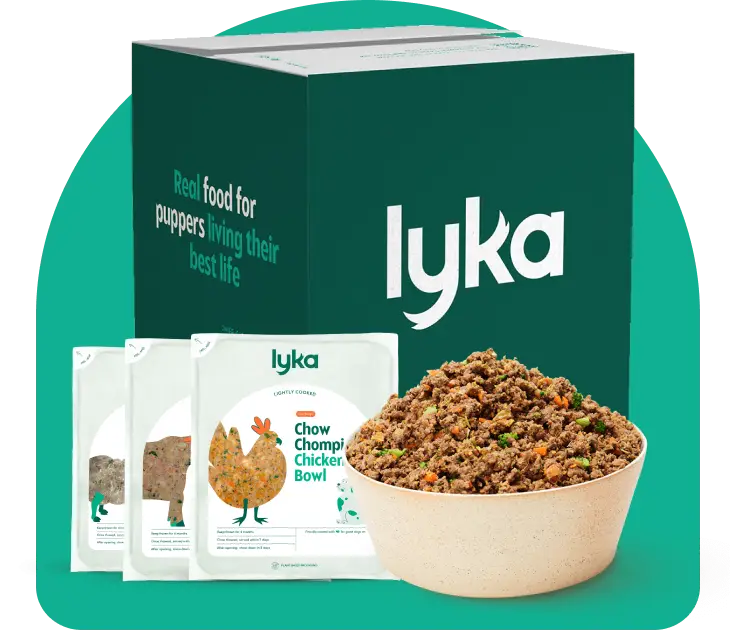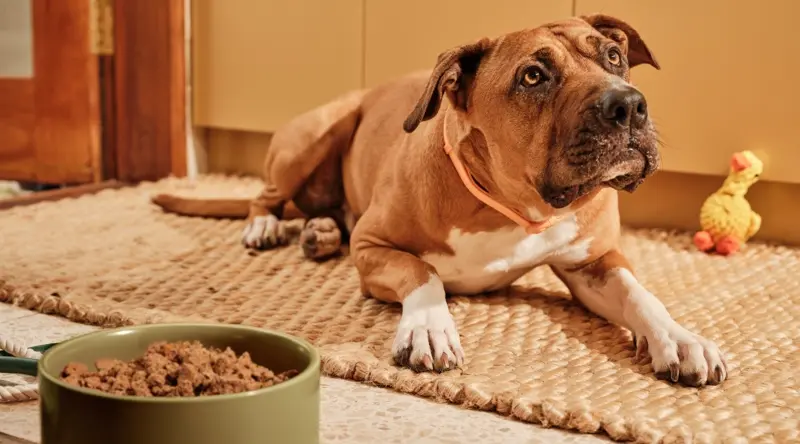You’ve just switched to your dog’s second food brand this month. Things started well, but now they’re sniffing their bowl, turning away, and giving you that unmistakable look of disappointment.
Dog not eating? Dealing with your dog’s fussiness is a challenge, and constant trial and error can be disheartening (and expensive) — all you want is for your dog to enjoy their food!
We get it. So, what’s the answer?
Getting to the root cause of your dog’s fussiness is the best way forward. Then complimenting the right food with tried and tested techniques could be a game-changer for you both.
8 reasons your dog is a fussy eater
Dogs can be fussy for several reasons, like health issues, boredom with their current kibble, or even just the quality of the food itself.
The first step is uncovering your pup’s unique preferences and experiences with food, which often requires a bit of patience and experimentation.
If you’re concerned about your dog’s fussy eating patterns, your vet is always your first port of call.
1. Food quality
Low-quality dog food, especially the heavily processed kind, might make your dog turn up their nose. Foods loaded with vegetable fibre, carbohydrates (think wheat, corn, rice), legumes, and animal by-products lack the high-quality proteins and fresh ingredients dogs thrive on.
In high proportions, these ingredients can cause digestive issues like bloating and discomfort, making your dog associate mealtime with an upset stomach. No wonder they’re not keen to eat!
We often think in terms of dog food and human food. But what’s good for humans is often good for our pups too – especially when it comes to quality, variety, and fresh whole foods.
Try this:
Fresh food for fussy dogs: fresh dog food, like Lyka, is packed with high-quality proteins, nutrient-dense ingredients, and superfoods. These meals are gently cooked to be easy on the stomach and delicious to picky eaters.
2. Food preferences in dogs
Like us, dogs have tastebuds that identify sweet, sour, salty, bitter, and umami. This means dogs can have preferences for specific flavours, smells, or consistencies.
Ever notice how your dog gobbles up the roast chicken or sardines but barely touches the rest of their food? Fresh, minimally processed foods tend to have flavours and smells that dogs find irresistible.
Many kibble brands add flavouring to make the dry food palatable because the manufacturing process affects the integrity of the ingredients.
Try this:
Enhance aroma: heat your dog’s food or add a bit of warm water to bring out the delicious smells.
Add a tasty topper: sprinkle Lyka’s Beef and Parmesan Topper to make their meal even more enticing. It’s a guilt-free, real food boost.
)
🐩 Read more: How to understand your dog’s tastebuds →
3. Meal fatigue
Eating the same dry food day in and day out can become boring for dogs. If your dog won’t eat kibble, but eats everything else, they may have kibble fatigue.
Try this:
Add more variety: introduce a fresh diet with a mix of nutritious ingredients. Lyka’s range of 6 different protein meals can help rekindle your dog’s enthusiasm for food.
🐩 Read more: Freshly cooked vs kibble for dogs: which is better?→
4. Rapid dietary changes
Sudden changes in your dog’s diet can cause picky eating. If you’ve moved from kibble to fresh food, the new textures and flavours might be a little overwhelming at first. It can also take a few days for their gut microbiome to adjust to the new ingredients.
Try this:
Introduce new food slowly: mix the new food gradually with your dog’s current diet over 5 days. Increase the new food a little each day to help them get comfortable.
🐩 Read more: Lyka’s step-by-step feeding guide: how to switch your dog to real food→
)
5. Health issues
If your dog suddenly won’t eat their food, there might be an underlying health issue at play.
Food sensitivities can trigger skin and gastrointestinal conditions, leading to food aversion, often mistaken for fussiness. A stomach upset, inflammation, or an infection can also affect a dog’s desire to eat.
Try this:
Book a vet check-up: if you suspect a health issue, it’s always best to get a professional opinion. Your vet can help identify any conditions that might be affecting your dog’s appetite.
Consider an elimination diet: with your vet’s guidance, an elimination diet can help pinpoint any specific food sensitivities that could be causing your dog’s aversion to food.
6. Stress-related eating issues
Stress and anxiety can make dogs lose their appetite. Big changes like moving, a new family member, or even just changes in routine can throw them off. They might also feel anxious if they're competing with other pets at mealtimes.
Try this:
Reduce the stressors: for predictable changes, like moving, try to introduce them slowly. For unexpected changes, give your dog extra comfort and reassurance. Tempt them with fresh food or single-protein treats to encourage eating.
Create a calm eating environment: find a quiet spot for your dog to eat without distractions, making mealtimes a more relaxed experience.
🐩 Read more: Feeding fussy dogs: is anxiety the problem?→
7. Lack of appetite (inappetence)
A dog's appetite often changes based on their energy needs, which are influenced by their level of physical activity. After vigorous exercise, such as long hikes or intense play, dogs burn more energy and may feel hungrier.
Try this:
Pre-dinner walk: a short walk before dinner can help build up an appetite. Just make sure not to exercise your dog immediately after eating to avoid any digestive issues.
Tailored exercise routine: Not sure how much exercise your dog needs? Consult your vet to determine the best type and frequency based on their age, breed, and health.
8. Age and life stage
Your dog’s age can also affect their eating habits. Puppies and older dogs often have different dietary needs and preferences.
Puppies don’t need special puppy food if they’re getting a fresh, nutrient-dense, balanced diet. Similarly, older dogs don’t necessarily need ‘senior’ dog food but can benefit from meals rich in antioxidants and anti-inflammatories to support their aging bodies.
Try this:
Small dog, big appetite: as puppies grow, their portion sizes change. Lyka can help by tailoring portions to your puppy’s needs as they hit growth milestones. If your puppy is not eating kibble, consider switching to gently cooked fresh food that’s easy to eat and digest.
Getting the right balance for seniors: a lighter diet that’s rich in nutrients, but lower in calories is an excellent way to keep your golden oldie in tip-top condition, like Lyka’s Chicken or Kangaroo meals. All Lyka meals contain anti-inflammatory omega-3 from fish or fish oil to promote joint health – great for senior dogs.
🐩 Read more: How to feed your fussy pup: tried and tested top tips from the Lyka community→
Lyka: a game-changer for fussy pups
Understanding your dog’s fussy eating habits can transform mealtime from a struggle into a joy.
Designed by board-certified veterinary nutritionists, Lyka meals are designed to be complete, balanced, and packed with real, gently cooked ingredients. With 6 delicious protein-rich meals designed to match your dog’s unique tastes and needs, even picky eaters will be excited at mealtime.
Give your dog meals that bring excitement and health to every bowl, because a well-fed pup is a happy pup.
)
)
)

)
)
)
)
